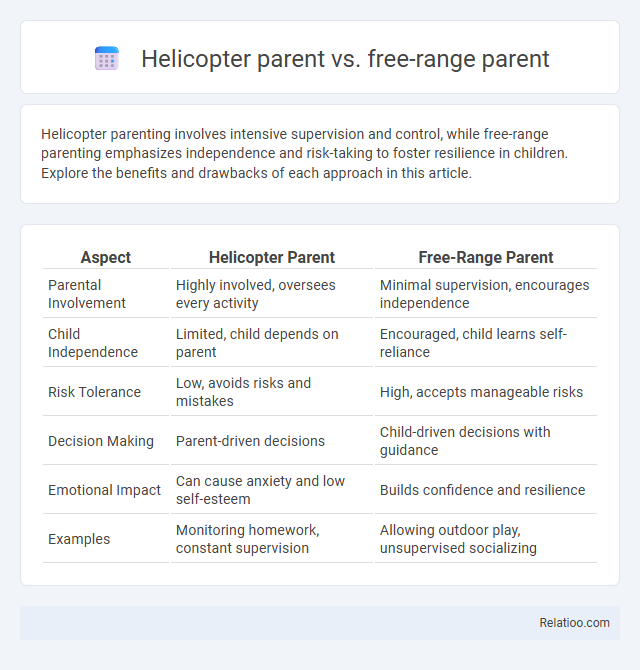Helicopter parenting involves intensive supervision and control, while free-range parenting emphasizes independence and risk-taking to foster resilience in children. Explore the benefits and drawbacks of each approach in this article.
Table of Comparison
| Aspect | Helicopter Parent | Free-Range Parent |
|---|---|---|
| Parental Involvement | Highly involved, oversees every activity | Minimal supervision, encourages independence |
| Child Independence | Limited, child depends on parent | Encouraged, child learns self-reliance |
| Risk Tolerance | Low, avoids risks and mistakes | High, accepts manageable risks |
| Decision Making | Parent-driven decisions | Child-driven decisions with guidance |
| Emotional Impact | Can cause anxiety and low self-esteem | Builds confidence and resilience |
| Examples | Monitoring homework, constant supervision | Allowing outdoor play, unsupervised socializing |
Understanding Helicopter Parenting
Helicopter parenting involves excessive involvement and control over a child's life, potentially hindering their independence and problem-solving skills. Free-range parenting, in contrast, encourages autonomy by allowing children to explore and learn through natural consequences. Understanding helicopter parenting helps you strike a balance between providing guidance and fostering your child's growth and resilience.
Defining Free-Range Parenting
Free-range parenting emphasizes granting children substantial independence and encouraging exploration with minimal supervision, fostering self-reliance and problem-solving skills. Unlike helicopter parents who closely monitor and intervene in every aspect of a child's life to ensure safety and success, free-range parents trust their children to navigate risks and develop autonomy. This parenting style balances the need for guidance with the recognition that experiential learning is crucial for healthy development.
Core Values and Beliefs Compared
Helicopter parents prioritize safety and control, believing close supervision prevents risks and failure, while free-range parents emphasize independence and resilience, trusting children learn through exploration and autonomy. Tiger parents focus on discipline and academic excellence, expecting high achievement and strict adherence to rules as pathways to success. Each parenting style reflects distinct core values: protection and guidance for helicopter, freedom and self-reliance for free-range, and structure and achievement for tiger parents.
Impact on Child Development
Helicopter parents often limit children's independence by closely monitoring their activities, potentially hindering the development of problem-solving skills and self-confidence. Free-range parenting promotes autonomy and resilience by allowing children to explore and learn from natural consequences, fostering essential life skills. Your child's development benefits most when a balanced approach is taken, combining guidance with opportunities for independence.
Academic Performance and Independence
Helicopter parents often closely monitor and control their child's academic performance, which can lead to high grades but hinder the development of independent problem-solving skills. Free-range parents encourage autonomy, fostering independence and self-motivation that can improve long-term academic resilience and critical thinking. Your child's success balances structured support with opportunities for independent learning, promoting both strong academics and personal growth.
Social Skills and Emotional Health
Helicopter parents often hinder social skills development by over-managing Your interactions, leading to dependence and anxiety. Free-range parents encourage autonomy and problem-solving, fostering resilience and better emotional health in children. Balancing involvement allows for nurturing social competence while supporting emotional well-being effectively.
Safety Concerns and Risk Management
Helicopter parents prioritize constant supervision and intervention to minimize risks, often limiting their child's exposure to potential dangers but potentially hindering independence. Free-range parents emphasize safety by teaching children risk assessment and allowing exploration with minimal intervention, fostering resilience and decision-making skills. Understanding your family's approach to safety concerns and risk management can help balance protection with the development of your child's autonomy.
Long-Term Outcomes for Children
Helicopter parenting often leads to children experiencing lower self-esteem, reduced problem-solving skills, and increased anxiety due to overprotection and limited independence. In contrast, free-range parenting encourages autonomy, fostering resilience, critical thinking, and higher long-term emotional well-being in children. Balanced parenting that allows guidance without excessive control supports optimal development, promoting responsibility and adaptive coping mechanisms throughout adulthood.
Cultural and Societal Influences
Helicopter parenting, characterized by intense supervision and control, often emerges in societies with high academic and safety pressures, such as parts of East Asia and North America. Free-range parenting, which promotes independence and risk-taking, is more common in cultures valuing individualism and self-reliance, like many Western European countries and rural areas. Societal norms, economic stability, and urbanization significantly shape parenting styles by influencing parental perceptions of safety and success.
Choosing the Right Parenting Style
Choosing the right parenting style requires understanding the differences between helicopter, free-range, and authoritative approaches to foster your child's independence while ensuring safety and support. Helicopter parents closely monitor their children, potentially limiting autonomy, whereas free-range parents encourage exploration and risk-taking with minimal supervision. Striking a balance by adopting an authoritative style promotes healthy development through clear boundaries and open communication, helping you nurture confident, responsible children.

Infographic: Helicopter parent vs Free-range parent
 relatioo.com
relatioo.com